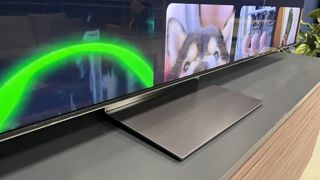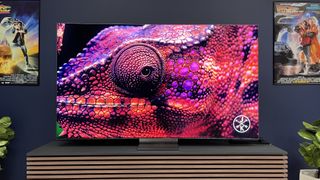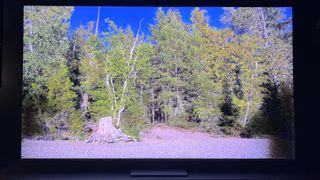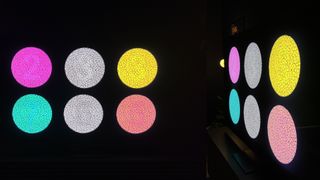Early Verdict
Samsung’s flagship 8K model serves up bright images with powerful HDR highlights and refined-looking shadows. It looks fantastic with real 8K content and also does an impressive job of upscaling 4K and HD-quality images. The only downside here is the price, with the new models arriving at a substantially higher cost than last year’s QN900C series.
Pros
- +
Powerful brightness
- +
High-quality upscaling
- +
Elegant design
Cons
- –
Expensive
- –
Some off-axis picture contrast fade
- –
Connectivity issues on test unit
Why you can trust TechRadar We spend hours testing every product or service we review, so you can be sure you’re buying the best. Find out more about how we test.
The Samsung QN900D, the company’s best 8K TV for 2024, is a very different beast from last year’s flagship Samsung QN900C mini-LED model, with one big change being an Infinity screen design with a shiny metal “Infinity Air Stand» that gives the TV a floating-on-air appearance. Otherwise, Samsung continues to be the main TV maker flying the 8K TV flag, and its flagship 8K set is a powerful showcase for the format, which continues to be in short supply outside of YouTube streams.
Samsung’s 8K TVs for 2024 also benefit from a processor refresh. The new version is called the Neural Quantum processor 8K Pro and it features 512 neural networks – eight times as many as last year’s model – to bring powerful AI capabilities to the new TVs. These include Quantum Super Resolution Pro AI upscaling to fill out the vastly higher number of pixels in an 8K TV’s display panel compared with a 4K TV. Another AI-driven feature is Real Depth Enhancer Pro, which, according to Samsung, «maximizes mini-LED control to enhance contrast even in fast-moving scenes».
A new Samsung picture processing feature, and one that’s exclusive to the QN900D, is AI Motion Enhancer Pro. This uses a ball-tracking algorithm that kicks in when watching sports and uses picture information from an onboard database to fill in any visual gaps of a ball in motion frame-by-frame. I didn’t get a chance to try this feature out during my hands-on test of the QN900D, but I did get a demo of it at Samsung’s HQ and it was highly effective at its intended task.

The QN900D series is now available for pre-order in 65-, 75-, and 85-inch screen sizes with prices starting at $4,999 (around £3,950 / AU$7,645) for the 65-inch up to $7,999 (around £6,325 / AU$12,235). That’s a big step up compared to last year’s 8K flagship, which was initially listed at $3,999. For further pricing context, Samsung’s 2023 flagship 4K TV series, the Samsung QN90C, initially listed at $2,299 for a 65-inch screen size.
The QN900D’s slim display is made possible by a One Connect box with a new more compact design that features four HDMI 2.1 ports with support for up to 4K 240Hz VRR for gaming – a first for a consumer TV. The 85-inch model I tested has a 6.2.4-channel speaker system powered by 90 watts, with support for Object Tracking Sound+ to better link sound effects to onscreen action and Q Symphony for combining the output of the TV’s speakers with a compatible Samsung soundbar.
As mentioned above, the QN900D’s One Connect Box has four HDMI 2.1 inputs with up to 4K 240Hz support, making it a great option for gaming. Similar to other Samsung TVs, it has Samsung Gaming Hub, a one-stop shop for accessing games on connected consoles and from cloud gaming services such as Xbox, Nvidia GeForce Now, Utomik, Luna, Boosteroid, and more. Gaming Hub now offers customization based on personal preferences and Samsung’s on-screen Game Bar menu has an AI Auto Mode that automatically adjusts picture and sound settings based on game genre.

Picture performance
After setting the QN900D to its Movie preset – typically the most accurate picture mode on Samsung TVs – I got down to business by streaming 8K nature clips from YouTube. In that mode, the 85-inch model used for my hands-on test was wonderfully bright and the landscapes, mosques, lizards, sloths, and humans that spilled across its screen all looked wonderfully clear and crisp. I had been impressed with how last year’s QN900C handled actual 8K content, but it looked even better on the QN900D.
Given the current lack of 8K source material, 4K and HD are what you’ll mainly be watching on the QN900D and Samsung’s top TV did an excellent job of upscaling 4K and lower-resolution sources for 8K display. Viewing the demonstration reel on the Spears & Munsil Ultra HD Benchmark 4K Blu-ray test disc, a shot of spindly trees on a beach showed a high level of fine detail in the branches and rocks, with no sign of artificial-looking enhancement. Even with my face pressed close to the screen I saw a solid, detailed image, and I had the same impression across several discs I played.
The QN900D’s local dimming also proved excellent, with powerful HDR highlights balanced by deep, detailed shadows. I didn’t have time to watch a wide range of reference movie clips, but I noted very few instances of backlight blooming on some of my go-to tests for that issue. This is probably too early a call for a hands-on review, but this year’s Samsung flagship has the most refined local dimming I’ve yet seen on a mini-LED TV.

As for numbers, we didn’t get a chance to do a full set of measurements during the hands-on test, but peak brightness on a 10% window in Filmmaker Mode was 2,338 nits, and a 100% window measured 520 nits. That’s notably higher peak brightness than the 2,000 nits we measured on last year’s QN900C. UHDA-P3 color space coverage was 92%, while BT.2020 coverage was 68%.
Samsung’s 8K TV clearly gets the important things right when it comes down to picture quality, but not all was perfect during my test. Screen glare was something of an issue when overhead lights were turned on in the room I tested the TV in, and so was off-axis uniformity, with picture contrast and color saturation fading to a degree when I viewed at an off-center seat. There was also a fair amount of judder and motion blur artifacts when I watched a reference scene from the James Bond film No Time to Die, though that could be remedied by making custom adjustments for both in the TV’s Motion menu.
More problematic during my test was a ‘sparkling’ artifact that showed up onscreen when I used 4K Blu-ray as a source. This appeared as a random pattern of uniform-colored pixelation noise that could be seen in darker images, and it persisted even after swapping out numerous discs, HDMI cables, and even 4K Blu-ray players. After my session, Samsung assured me the problem was isolated to the specific unit I tested and that the sparkling issue wasn’t visible when they later swapped out the TV’s One Connect box.

To 8K or not to 8K?
Samsung’s 8K flagship is a truly impressive TV. Everything about the QN900C, from its cosmetic design to the pristine-looking images it displayed with both 4K and 8K sources, grabbed my attention. It’s too bad that connection issues with 4K Blu-ray popped up during my test, because otherwise I’d be inclined to give it two thumbs up out of the gate. For now, any such conclusion is conditional until we test a perfectly functioning unit.
Each passing year sees Samsung improve its 8K upscaling, and with the QN900D, it’s arrived at the point where it almost doesn’t matter if you’re not watching real 8K, because everything looks so good. Paying for that improvement is another matter, especially since the best TVs on the market also provide exceptional picture quality. Samsung’s big price boost for its 8K TVs in 2024 won’t help matters, but I’m certain anyone who buys a QN900D will be very pleased with what they’re getting.
You might also like
What is a hands on review?
Hands on reviews’ are a journalist’s first impressions of a piece of kit based on spending some time with it. It may be just a few moments, or a few hours. The important thing is we have been able to play with it ourselves and can give you some sense of what it’s like to use, even if it’s only an embryonic view. For more information, see TechRadar’s Reviews Guarantee.
